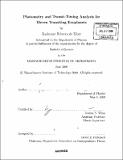Photometry and transit-timing analysis for eleven transiting exoplanets
Author(s)
De Kleer, Katherine Rebecca
DownloadFull printable version (3.733Mb)
Other Contributors
Massachusetts Institute of Technology. Dept. of Physics.
Advisor
Joshua N. Will.
Terms of use
Metadata
Show full item recordAbstract
This thesis presents time-series photometry of transits of 11 different extrasolar planets. Observations were conducted with the Fred L. Whipple Observatory 1.2m telescope and the Wise Observatory im telescope, in standard optical bandpasses. The number of transits observed for each planet ranges between one and 20 transits, and differential aperture photometry is performed for each transit observation. For the system TrES-2, this thesis examines 14 different different transit observations. Because of this large quantity of data, the parameters Rp/R., b, a/R., and i are also fitted for with precision using the Markov Chain Monte Carlo technique, and the resultant parameter values are presented. Transit-timing analysis is performed on all systems: CoRoT-2, GJ436, HAT-P-1, HD17156, HD189733, TrES-1, TrES-2, WASP-2, WASP-3, XO-1, XO-2, and XO-3. Transit timing is important both for constraining the orbital period and to search for variations in the transit-to-transit interval that could indicate the presence of an unseen companion planet. The transit center times for nearly all observations are found, and the planetary periods for all systems are calculated. In many cases these periods are determined with much greater precision than previously known. It is found that systems XO-2 and HAT-P-1 are consistent with a constant period, but our data are not conclusive with regards to the other systems.
Description
Thesis (S.B.)--Massachusetts Institute of Technology, Dept. of Physics, 2009. Includes bibliographical references (leaves 101-102).
Date issued
2009Department
Massachusetts Institute of Technology. Department of PhysicsPublisher
Massachusetts Institute of Technology
Keywords
Physics.